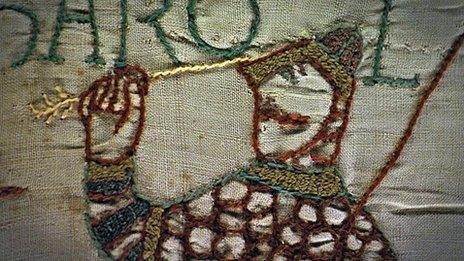Bayeux Tapestry 'made by same people in same place'
- Published

The tapestry depicts the events surrounding the Norman Conquest
A researcher at the University of Manchester has made a new claim about how the Bayeux Tapestry was made over 900 years ago.
The widely-accepted theory is that it was created by teams of nuns across England, in nine sections which were then stitched together.
PhD researcher Alexandra Makin said the needlework is "consistent throughout".
This, she said, implies that one group of specialist embroiderers worked on it, in the same place at the same time.
Mrs Makin said: "Some people argue that the style of some figures are so different they must have been embroidered by different people.
"But my view is it's not the embroidery which is different - but the way the characters were drawn."
The outlines for individual sections were worked first, and then filled in with colours in a set order, Mrs Makin believes.
"The achievement of these people is quite remarkable when you consider the conditions they worked in," she said.
"They would have almost certainly worked in daylight hours only, using basic equipment, but they would have been well regarded by society."
The 70m (230ft) long tapestry was commissioned by William the Conqueror's half-brother, Bishop Odo of Bayeux, depicting the events surrounding the Norman Conquest, and culminating in the Battle of Hastings.
It consists of 50 scenes with Latin captions, embroidered on linen with coloured woollen yarns, and is on permanent display at a museum in Normandy, France.
Sylvette Lemagnen, curator of the tapestry, said she was "delighted" with the study, saying it is "fundamental to the understanding of the Bayeux Tapestry".
- Published1 October 2012